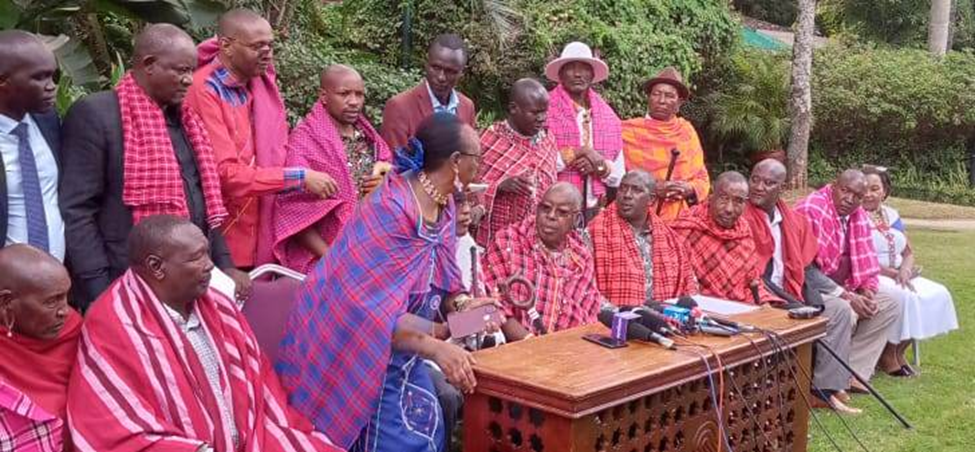
A section Samburu leaders addressing a press conference in Nairobi.
By Benard Mulwa
The disappearance of king Laibon Bari Kaldojan Ole-aduma (Leaduma) during the colonial era, took the center stage in a deliberation by the Samburu people even as pressure continues to mount at the British king his Majesty Charles 111 to disclose where their king Laibon kaldojan leaduma was buried after unlawful deportation.
Eight decades down the line, the Samburu have been struggling to seek answers to the disappearance of their king Laibon Bari Kaldojan Ole-aduma (Leaduma), who led them to resist the British colonial administration.
Perhaps, most affected is the larger Leaduma family, which still lives in Samburu County and whose generations directly descended from the freedom fighter. Lea duma’s name has spanned various generations in the history of the Samburu, besides featuring in legendary tales of heroism, folklore and sayings. He was a traditional prophet among the Samburu besides being the chief decision maker before the colonial administration came calling. Far and wide, the British colonial administration feared and viewed him as a unique being that possessed the powers of the mystic that could make the government not to work.
Even with no picture to identify his grandfather, 50-year-old Anthony Leaduma has since 1985 been struggling to trace the grave of the Laibon Leaduma and above all, seek justice for his unlawful deportation and possible execution by the British.
Our journey to trace descendants of the Laibon takes us to the remote village of Ngopeliani, located on the eastern edge of the serene Lorukoti plains, on the western side of the low lying Lorroki plateau in Samburu Central District. We trace the only surviving sons of the late Laibon – Lopeei Leaduma, 90, and his brother, 87-year-old Ledipen Leaduma.
This saw the Laibon transferred to Nakuru and Naivasha for further detention. The legal tussles involving the Laibon caught the attention of the then colonial governor of the Kenyan Protectorate, Joseph Aloysius Byrne, as Leaduma was largely seen as “dangerous to peace and order”.
Byrne issued a deportation letter against Laibon Leaduma on November 1934, ordering that he be deported to Kwale on the Kenyan coast. The British perceived Kwale as an ideal place that would permanently delink the Laibon from his native Samburu where he conducted his resistance activities against their rule. Besides, Kwale was regarded as the farthest point from Samburu.
“The said Laibon Ole-oduma shall forthwith be re-conveyed to Kwale and there detained during my pleasure in accordance with the terms of my said order dated the 15 February 1934. Given under my hand and the official seal of the colony at Nairobi this day of November 1934,”the deportation letter written by Byrne read in part.
Since then, no one knows the whether the Laibon Leaduma was executed or imprisoned for life. The question continues to linger in the minds of the larger Leaduma family, the Samburu people and many other Kenyans who have had a keen history of this little known freedom fighter,” A cautionary saying has even emerged in the Samburu language which warns people “not to find oneself in Leaduma’s troubles.” This saying is directly
“The said Laibon Ole-oduma shall forthwith be re-conveyed to Kwale and there detained during my pleasure in accordance with the terms of my said order dated the 15 February 1934. Given under my hand and the official seal of the colony at Nairobi this day of November 1934,”the deportation letter written by Byrne read in part.
Since then, no one knows the whether the Laibon Leaduma was executed or imprisoned for life. The question continues to linger in the minds of the larger Leaduma family, the Samburu people and many other Kenyans who have had a keen history of this little known freedom fighter,” A cautionary saying has even emerged in the Samburu language which warns people “not to find oneself in Leaduma’s troubles.” This saying is directly connected to the history of Leaduma.
It virtually translates to warning someone to be cautious and avoid possible danger. It depicts the grave situation that the Laibon was involved in and the fears his arrest instilled to those who saw it. Leaduma’s contribution to the fight for freedom was, however, less documented. John Bulyaar, the chief curator at the Kenyatta House Museum in Maralal town, Samburu County says the Oledume Road in Nairobi’s Kilimani is one of the landmarks identified with the late freedom fighter. He says many freedom fighters in several parts of northern Kenya have not been recognised as national heroes. The British conquered the Samburu region following the eventual deportation of the Laibon Leaduma. They had vast interests in ranching and crop farming as many parts of Samburu favoured their agricultural undertakings.
